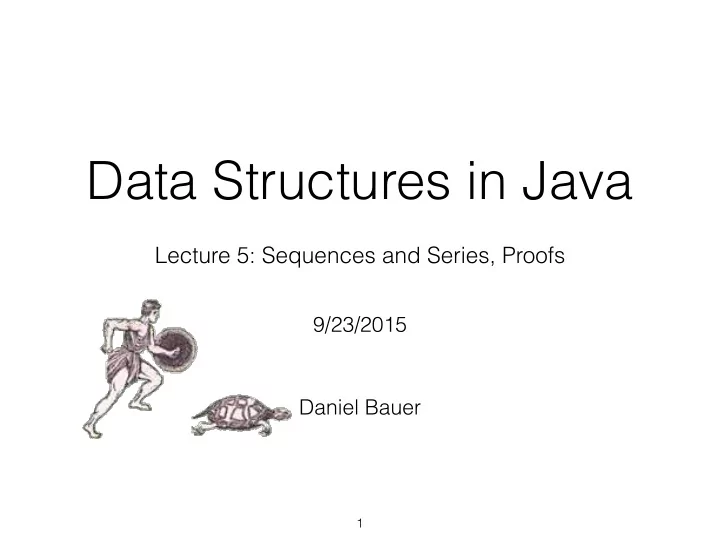

Data Structures in Java Lecture 5: Sequences and Series, Proofs 9/23/2015 Daniel Bauer 1
Algorithms • An algorithm is a clearly specified set of simple instructions to be followed to solve a problem. • Algorithm Analysis — Questions: • Does the algorithm terminate? • Does the algorithm solve the problem? (correctness) • What resources does the algorithm use? • Time / Space 2
Contents 1. Sequences and Series 2. Proofs 3
Sequences • What are these sequences? • 0, 2, 4, 6, 8, 10, … • 2, 4, 8, 16, 32, 64, … • 1, 1/2, 1/4, 1/8, 1/16, … 4
Sequences • What are these sequences? Arithmetic Sequence • 0, 2, 4, 6, 8, 10, … • 2, 4, 8, 16, 32, 64, … • 1, 1/2, 1/4, 1/8, 1/16, … 4
Sequences • What are these sequences? Arithmetic Sequence • 0, 2, 4, 6, 8, 10, … • 2, 4, 8, 16, 32, 64, … Geometric Sequence • 1, 1/2, 1/4, 1/8, 1/16, … 4
Arithmetic Series 5
Arithmetic Series • Arithmetic Sequence of length N , with start term a and common difference d. 5
Arithmetic Series • Arithmetic Sequence of length N , with start term a and common difference d. • Series: The sum of all elements of a sequence. 5
Sum-Formulas for Arithmetic Series • In particular (for a =1 and d =1): 6
Geometric Series 7
Geometric Series • Geometric Sequence with start term s and common ratio A. 7
Geometric Series • Geometric Sequence with start term s and common ratio A. • Geometric Series: 7
Geometric Series • Geometric Sequence with start term s and common ratio A. • Geometric Series: • Often 0 < A < 1 or A = 2 7
Sum-Formulas for Finite Geometric Series 8
Sum-Formulas for Finite Geometric Series • In particular, if s=1 8
Sum-Formulas for Finite Geometric Series • In particular, if s=1 • In Computer Science we often have A = 2 8
Sum-Formulas for Infinite Geometric Series only if 0<A<1 9
Sum-Formulas for Infinite Geometric Series only if 0<A<1 • In particular, if s=1 and 9
Sum-Formulas for Infinite Geometric Series only if 0<A<1 • In particular, if s=1 and • For instance, 9
Analyzing the Towers of Hanoi Recurrence base case: geometric series 10
The End of The World Legend says that, at the beginning of time, priests were given a puzzle with 64 golden disks. Once they finish moving all the disks according to the rules, the wold is said to end. If the priests move the disks at a rate of 1 disk/second, how long will it take to solve the puzzle? 11
The End of The World Legend says that, at the beginning of time, priests were given a puzzle with 64 golden disks. Once they finish moving all the disks according to the rules, the wold is said to end. If the priests move the disks at a rate of 1 disk/second, how long will it take to solve the puzzle? 11
The End of The World Legend says that, at the beginning of time, priests were given a puzzle with 64 golden disks. Once they finish moving all the disks according to the rules, the wold is said to end. If the priests move the disks at a rate of 1 disk/second, how long will it take to solve the puzzle? seconds minutes days years 11
Contents 1. Sequences and Series 2. Proofs 12
Types of Proofs • Proof by Induction • Proof by Contradiction • Proof by Counterexample 13
Proofs by Induction • We are proving a theorem T. (“this property holds for all cases.”). • Step 1: Base case. We know that T holds (trivially) for some small value. • Step 2: Inductive step: • Inductive Hypothesis: Assume T holds for all cases up to some limit k. • Show that T also holds for k+1. • This proves that T holds for any k. 14
Proof by Induction - Example • For the Fibonacci numbers, we prove that • Base case: • Inductive step: • Assume the theorem holds for i = 1,2,…, k • We need to show that 15
Proof by Induction - Inductive Step • We know that and by the inductive hypothesis: 16
Proof by Counter-Example • We are proving that theorem T is false . (“this property does not hold for all cases.”). • It is sufficient to show that there is a case for which T does not hold. • Example: • Show that is false. • There are i for which ,e.g. 17
Proof by Contradiction • We want to proof that T is true. • Step 1: Assume T is false. • Step 2: Show that this assumption leads to a contradiction. 18
Proof by Contradiction - Example • We want to proof that there is an infinite number of primes. • Assume the number of primes is finite and the largest prime it P k . • Let the sequence of all primes be P 1 , P 2 ,,…,P k • Since N> P k, N cannot be prime, so it must have a factorization into primes. Such a factorization cannot exist: dividing N by any P 1 , P 2 ,,…,P k will always leave a remainder of 1. 19
Recommend
More recommend